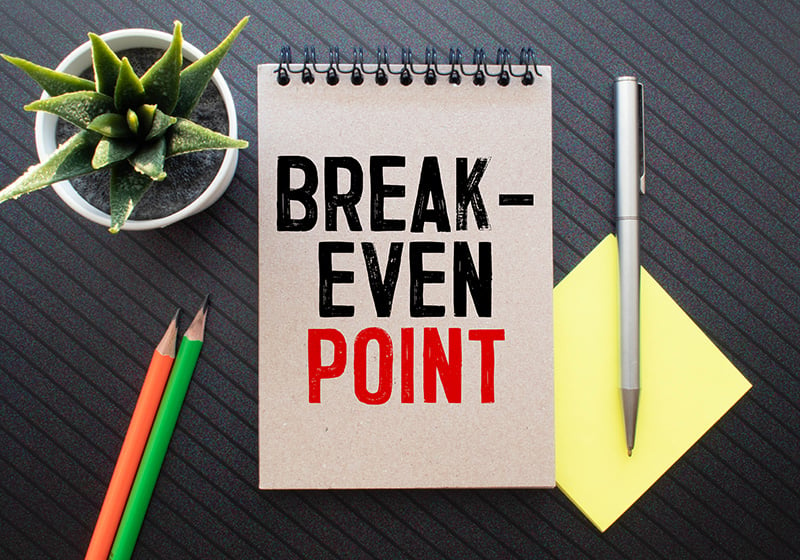Table of Contents
Break-even point: what it is and how to calculate it
If you’re putting together a business plan for a start-up, you’ve probably already familiar with the so-called break-even point. Conducting a break-even analysis is one of the key steps in starting a new business – be it an online operation or a bricks-and-mortar shop.

Today, we’re looking in detail at what the break-even point is and how to calculate it.
What is the break-even point?
The break-even point (BEP) is the point at which a business’s revenue covers all of its costs.
So, the break-even point gives business owners an idea of when revenue from products sold will equal all costs. Once the break-even point has been reached, each subsequent sale will earn profit for the company.
As you might imagine, calculating the break-even point is vital for business owners, especially when they are launching a new venture or product line. That’s why it’s a fundamental part of a business plan.
How to calculate the break-even point
To calculate the break-even point, people often use the break-even chart. You can see this below.

On the break-even chart, one line represents the total costs (fixed plus variable costs) of a business; the other line represents revenue. The point at which the volume of revenue covers total costs – in other words, where the two lines cross – is the break-even point.
The formula for calculating the break-even point is this:
Break-even point = Fixed costs ÷ (Sales price per product unit – variable cost per product unit)
Calculating the break-even point involves taking the fixed costs of a company and dividing them by the difference between the price of a single unit of a product and its variable costs. The result is the number of products that must be sold to reach the break-even point.
- Fixed costs are those costs that remain the same, regardless of whether the firm’s output increases or decreases: for example, costs for starting the business, rent, staff, infrastructure and external consultants.
- Variable costs are costs that vary, increasing or decreasing due to a range of factors, the most important of which is the number of units produced. Examples include the cost of raw materials and parts, the cost of energy used for production, and the commission that an e-commerce platform charges on sales.
We should point out that differentiating between a company’s fixed and variable costs is not always straightforward, and this is one of the main challenges in calculating the break-even point. Some costs that seem fixed can actually become variable over the long term. We therefore always recommend consulting a professional when calculating your break-even point.
Why is calculating the break-even point useful?
Despite the difficulty in calculating the break-even point – and some limitations that we’ll look at below – this analysis is a key step that anyone who wants to start a business or open a shop must take.

It offers a number of advantages
Reducing business risk
Calculating the break-even point makes it immediately clear whether a business idea is viable or not. That’s why it’s one of the most important factors for reducing business risk.
Setting the right product price
The break-even point is an important indicator – although of course not the only one – for figuring out what price a single product should be sold at. If the price is too low, the break-even point will be too high, so the price will need to be adjusted.
However, there are other factors that must also be taken into account when setting prices, such as the market and consumer psychology.
Planning better and more rationally.
Calculating the break-even point tells you how many product units you need to sell in a given period, such as every month. If the break-even point is too high, you will need to take action to bring it down: for example, by increasing the price or finding a strategy for cutting costs, whether fixed or variable.
Securing new financing.
Working out the break-even point is an important part of your business plan. This analysis is usually required by potential investors to assess the soundness and feasibility of your business idea. Break-even analysis can therefore help you to access new financing.
What are the limitations of break-even analysis?
Break-even analysis is undoubtedly useful. In fact – as we’ve seen – it’s fundamental for any business venture that you’re embarking on. That said, it does have limitations that must be remembered to fully understand the meaning of the break-even point, how to use it and how much to trust this metric.

The main shortcomings of break-even analysis stem from the fact that it doesn’t take into account a number of variables like time, demand and market fluctuations. As a result, it’s a somewhat static model that, while providing us with useful guidance, doesn’t change dynamically as variables change. That’s why this tool must be used together with other metrics – like cash flow ( ) – in order to avoid nasty surprises for your business.
Have you already calculated the break-even point for your new business venture?
DISCLAIMER: This article explains what the break-even point is in layman’s terms for informational purposes only; this information should not in any way be understood as legal advice. We advise that you always seek the advice of an accountant or business consultant for up-to-date and specific information about your particular circumstances.

